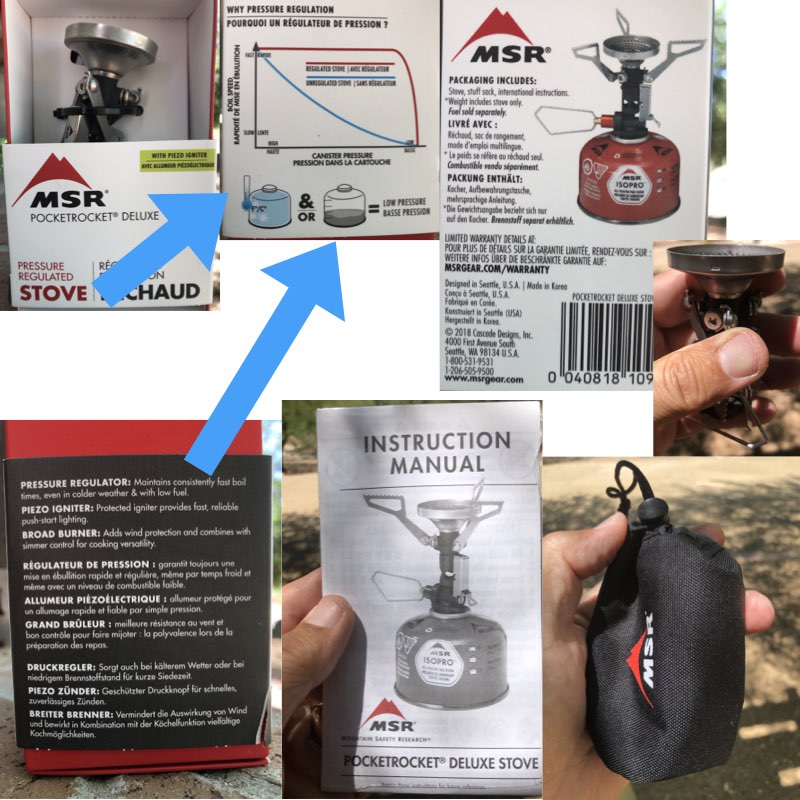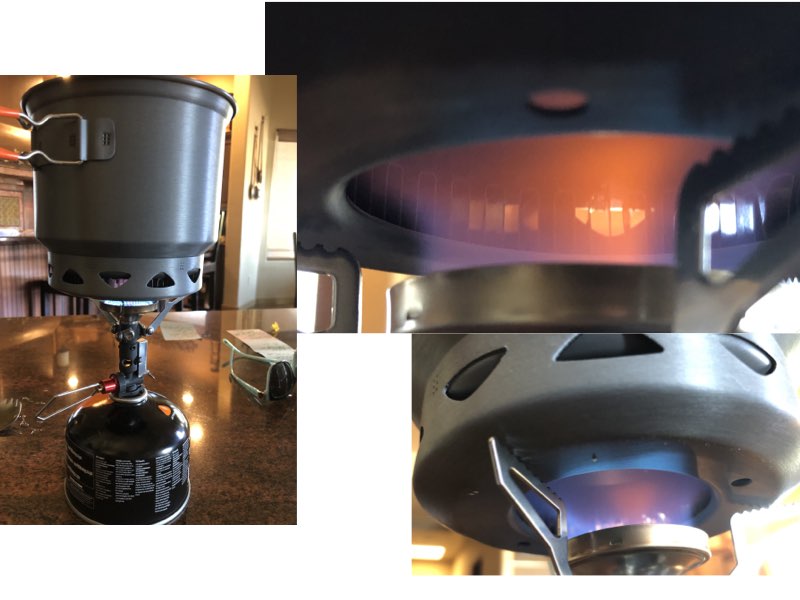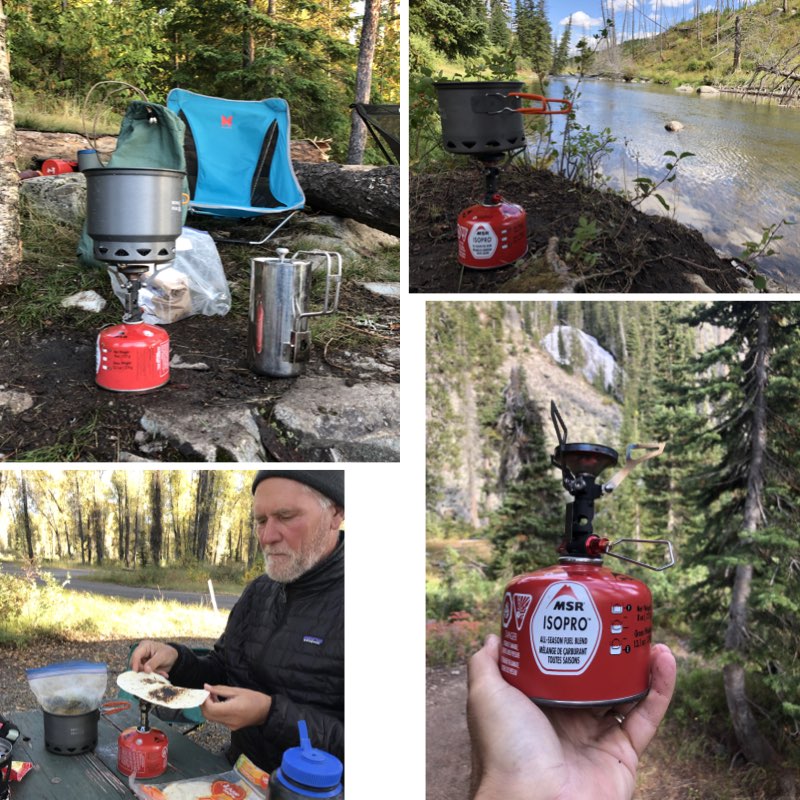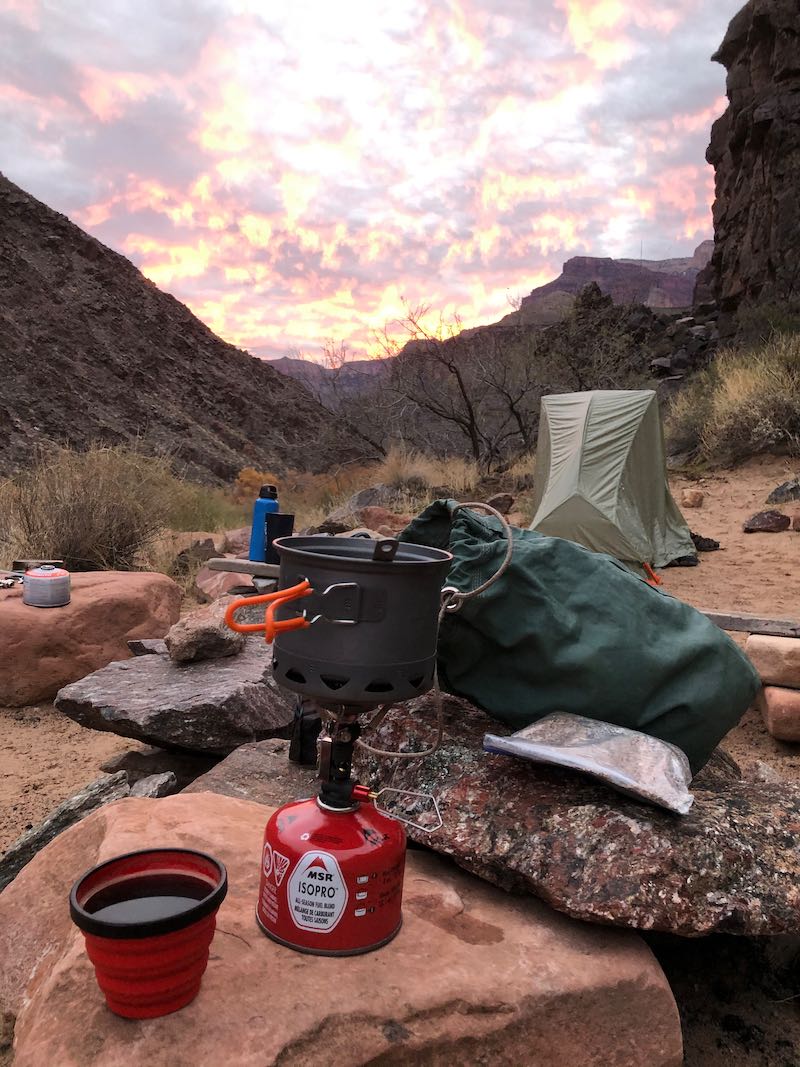

 |
 |
 |
Guest - Not logged in | ||||||||||||||||||||||||||||||||||||||||||||||||||||||||||||||||||||||||||||||||||||||||||||||
Reviews > Cook and Food Storage Gear > Stoves > MSR Pocket Rocket Deluxe 2019 > Test Report by Kurt PapkeMSR Pocket Rocket Deluxe Stove
| |||||||||||||||||||||||||||||||||||||||||||||||||||||||||||||||||||||||||||||||||||||||||||||||
| Name: | Kurt Papke |
| Age: | 65 (I'll be 66 at the time of the Field Report) |
| Gender: | Male |
| Height: | 6' 4" (193 cm) |
| Weight: | 230 lbs (105 kg) |
| Email address: | kwpapke (at) gmail (dot) com |
| City, State, Country: | Tucson, Arizona USA |
The PocketRocket Deluxe stove is a stand-alone burner for
canister fuel. It is not an integrated cook kit, i.e. it
does not include a pot, lid, etc. It distinguishes itself
from the other stoves in the MSR line by including an igniter and
a regulator. It has a wide bowl-shaped gas diffuser for
rapid water boiling and wind protection.
| Product Information |
|
| Manufacturer |
Mountain Safety Research (MSR), part of Cascade Designs
Inc. |
| Manufacturer website |
https://www.msrgear.com/ |
| Products tested |
PocketRocket Deluxe Stove |
| Country of manufacture |
Korea |
| Materials |
Contains some brass. Mostly metal, some
small plastic parts |
| Warranty |
This 3-year Limited Warranty is provided to
you by Cascade Designs, Inc., a company doing business as
Mountain Safety Research (MSR). So long as you are the original purchaser, and you use your MSR product for the use it was intended (for example, stoves for boiling water outside, and not for roasting marshmallows), and you treat your products with care and maintain them properly, we warrant your product to be free from defects in materials and workmanship for three years. |
| List price |
USD $69.95 |
| Manufacturer's
spec |
Measured |
|
| Weight |
83 g (2.9 oz) |
82 g (2.9 oz) |
| Dimensions |
Width: 2.2 in (56 mm) Length (diffuser diameter): 1.8 in (46 mm) Height: 3.3 (84 mm) |
2.2 in (55 mm) 1.8 in (46 mm) 3.3 in (83 mm) |

Of course I had to try it out. Deploying the pot support legs is a little tricky. On most stoves they simply rotate up and down. I consulted the instruction manual and discovered these legs have two degrees of freedom: they rotate up and down, but also clockwise and counterclockwise. To deploy the legs they are rotated along both axes simultaneously. Ingenious and space-saving, but not obvious.
Of course I had to take it apart a bit, so I unscrewed the diffuser, looked down the stem at the igniter wire and could see a spark from the wire to the housing when the igniter lever was pressed. I screwed the diffuser back on again, screwed on a fuel canister and the igniter didn't light the flame. I lit it with a pocket lighter and everything worked fine.
The fuel control is pretty flimsy, but it takes a lot of travel to adjust the flame level so only minimal pressure is needed to adjust the fuel valve. The generous valve travel should make simmering easier, except in stiff winds which have a tendency to blow out stoves that are turned down.
I have a long history with canister stove igniters. I have another stove where I have replaced it twice in ten years and always carry a spare. They tend to be the least reliable component on a canister stove. I contacted my fellow tester Jerry Adams who had already filed his initial report and he had mentioned his igniter worked fine. After he received my query he unscrewed his diffuser and now his igniter didn't work! He is much smarter than me, and quickly figured out that the tube coming down from the diffuser must be placed over the igniter wire when screwing the diffuser back on again. I followed his instructions, and Eureka it worked! It would be good for MSR to document this. I wonder how many other users have unscrewed the diffuser and complained about the igniter not working.
My average lifetime on a piezoelectric igniter is about three years, so hopefully this one will work for the entire four month test period. It looks like it can be removed (and replaced) by loosening one screw. I checked the MSR website, and could not find a replacement part. Perhaps if and when the time comes, their customer support will send one out.
In preparation for heading our for a 5-week road/camping/backpacking/canoeing trip I thought it would be a good idea to test out the stove and check boil times and compatibility with the pots I was planning to use it with. My plan was to use the two pots that are part of a cook set I tested last year (see my report on the Mons Peak IX 123 UL HE cook set). These pots are lightweight and have a heat exchanger built into the bottom for efficiency. The stove that came with that cook set has a smaller diameter than the device under test, and I wanted to make sure the flame would be concentrated on the bottom of the pot and not on the support metal of the pots.
The reason I wanted to take two pot sizes is during the week of canoeing it's my job to make coffee for everyone in the morning. We bring a large French Press, and I wanted to be able to fill that with one boil. The larger pot in the cook set is 44 oz (1.3 L), perfect size. After the week of canoeing I planned to do several weeks of backpacking and wanted a lighter solo stove, and the smaller pot in the cook set is 25 oz (750 mL).
For my test I filled each of the two pots with 2 cups (473 mL) of tap water, and poured the water into the large pot and decanted 1/2 back to the small pot to make sure they were both the same temperature. I then brought them to a rolling boil and timed the result. The small pot hit a boil in exactly 2.5 minutes, and the large pot in just over 2 minutes. That's really good performance in my experience, but it was under ideal conditions, i.e. indoors with no wind and very warm water.

At left in the photo is the test setup with the larger pot. The two photos at right show the flame as it enters the heat exchanger on the pot bottom. Upper right is as the smaller pot, lower right is the larger. I was pleased with the match between the flame diameter and the pot geometry, and decided to proceed with these pots for my trip.
| Date |
Location |
Trail |
Distance Hiked |
Altitude |
Weather |
| August 31- September 8, 2019 |
Boundary Water
Canoe Area Wilderness near Grand Marais, Minnesota |
n/a |
paddled |
1420 ft |
Some sun, but mostly cloudy with several
rainy days. Temperatures 35-65 F (2-18 C) with gusty
winds |
| September 12-13, 2019 |
Absaroka-Beartooth Wilderness near Big
Timber, Montana |
West
Boulder River |
6 miles (9.7 km) |
5542-5866 ft (1689-1788 m) |
Mostly sunny, temperatures 45-65 F (7-18 C) |
| September 15-18, 2019 |
Yellowstone National Park, Wyoming |
Bechler
River Trail |
30 miles (48 km) |
6400-8600 ft (1950-2620 m) |
Sunny the first and last day, cold and rainy
the second and third day 25-65F (-4-18 C) |
| September 19-22, 2019 |
Grand Teton National Park, Wyoming |
Various |
7+12+14=33 miles (11+19+23=53 km) |
6750-10400 ft (2060-3170 m) |
Sunny the first and last day, cold and rainy
the second and third day 32-65F (0-18 C) |
| October 17-18, 2019 |
Santa Catalina Mountains just north of
Tucson, Arizona |
Romero Canyon |
12 miles (19 km) |
2700-5100 ft (820-1550 m) |
Sunny, warm, windy at night, 60-85 F (16-29 C) |

I am the official Coffee Maker of our canoeing group because I get up earlier than anyone else and I don't mind making lots of coffee in the morning. All our meal cooking was done on several MSR Whisperlite stoves, and all the coffee (except for the last day) was made on the stove under test.
I boiled all the water using an MSR IsoPro 8 oz (227 g) canister
and the large pot from the Mons Peak IX 123 UL HE Cook Set which
has a nice heat exchanger on the bottom for efficiency. This
pot has a volume of 43.9 fl oz (1300 mL). I was using this
large pot because I was making 1 L/qt of coffee at a time using a
stainless steel French press coffee pot. I made 3-4 of these
every morning for six mornings until I ran out of gas. The
photo in the above set at upper left shows my morning
coffee-making station.
My fellow campers were amazed at how well this stove worked,
especially the reliability of the igniter. I was pretty
impressed at how fast it can boil 1 L/qt of water -- this stove
doesn't mess around. I was however a bit disappointed that I
ran out of fuel. I figured the large canister would easily
last the whole week, but it did not.
Short overnight into an area I had never been to before.
Since I was backpacking I was more weight conscious than in the
canoe trip, so I switched to the smaller pot in the cook set which
has a volume of just 25.4 fl oz (750 mL). I used the same
pot in Yellowstone and the Grand Tetons as described below.
I cooked several meals including a hot lunch (depicted in the
photo set above at upper right). Everything worked
perfectly.
Four-day backpacking trip along the Bechler river, where I cooked all my meals using the stove under test. The photo in the above set at lower right shows the unit with Albright Falls in the background, perhaps the most scenic campsite I have ever been to in my life.
I made a hot dinner every night and on several mornings made hot
oatmeal for breakfast. With the oatmeal I appreciated the
regulator on the unit which allowed me to control the flame for a
near-simmer. With the windy conditions I had trouble keeping
the stove lit when trying to cook the oatmeal through once it was
brought to a boil, so I ended up firing it up for a few seconds
with as low a flame as possible until the meal began to bubble
again, then turning it off. This use accentuated to me the
value of having a reliable igniter - it was no big deal to relight
the stove several times to complete the cooking task as it lit so
easily and reliably. I was also pleased that I never burned
my oatmeal - the regulator plus the wide burner head allowed the
stove to act more subtly than a blowtorch.
Our last morning was pretty cold, around 25 F (-4 C).
Despite the cold, the stove fired right up and made my coffee and
oatmeal with no problems.
We had intentions of doing four days of backpacking, but when we arrived to get our walk-up permit the weather forecast looked horrendous. We opted to do day hikes instead, and as it turned out the weather was worse than predicted and we would have been hiking & camping in a major snowstorm with potential very bad outcomes.
We ended up car camping for five nights at the Gros Ventre campground within the park and using that as our base camp. We mostly cooked meals at out campsite with lunch on the trail. One of the techniques I worked on during this trip was perfecting the process of toasting tortillas over the stove. See photo in the set above at lower left. This worked incredibly well and my two companions started copying me after they tasted the result for the first time! The legs on the stove work quite well to support a tortilla - I could toast about 1/4 of the tortilla at a time, then rotated it and flipped it over and did the other side.
Once again I ran out of fuel on the last morning. My companions were still on their first canister and they cooked the same number of meals as I did, so I do question just how fuel efficient the stove is. I also noticed that I often had to click the igniter a few times to get the gas lit - I hope this is not a trend and it doesn't get any worse!
Just a quick overnight to try out some new gear. I had intended on hiking a bit further, but we are in a drought and it was incredibly dry up there. The spot where I like to camp had no water flow at all, the first time I've seen that in 10 years of hiking here in Tucson.
I cooked dinner on the stove, toasted a tortilla, made two cups of coffee the next morning and another hot tortilla. The stove performed flawlessly.
Since one of my other tests us an ultralight tent, I tried to
pack as light as possible on this trip. I appreciated just
how lightweight this stove is, as it represented such a small
fraction of my total gear weight.
Light, reliable, easy to set up and use. The igniter has
been fairly reliable so far. My only issue is that it does
seem to go through fuel pretty quickly compared to the integrated
canister stoves I am accustomed to using.
| Date |
Location |
Trail |
Distance Hiked |
Altitude |
Weather |
Base Weight |
Total Pack Weight |
| December 6-8, 2019 |
Grand Canyon National Park, Arizona |
Hermit |
18 miles (29 km) |
6630-2400 ft (2020-730 m) |
Partly cloudy, one night of rain, 38-65F (3-18 C) |
about 15 lb (6.8 kg) |
about 25 lb (11.3 kg) |
I led a group of four (we started with five...) hikers from the Tucson Backpacking Meetup group on what I advertised as "Beach Camping in the Grand Canyon". On day one we hiked down from the Hermit trailhead to Hermit Rapids and set up camp on the beach. Day two was pretty relaxed, we didn't get going until after lunch and only had a short hike up to the Hermit Creek campsite. Day three we got up early after a night of rain and hiked out.
I made hot dinners with the stove both nights, and two cups of instant coffee days two and three.
